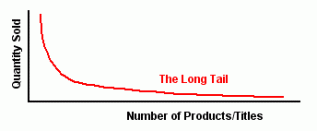The ‘long tail’ is the term used by Chris Anderson (2004) to describe how online retailers have the potential to achieve greater economic success than offline stores due to ‘unlimited shelf space to offer products’ (PCMag 2014) and the personalisation of the consumer experience. By monitoring consumers’ viewing and purchase history, recommendations are made about similar products and content that may interest them. This process allows for the ‘connection between niche audiences with niche productions’ (Kelly, 2008).
The online availability of media content has had a profound effect on what is considered popular entertainment. The graph (featured below) illustrates that while ‘hits’ (popular products/titles) have high sales, there is a consistent consumer demand for niche products and titles. E-commerce company Amazon and media streaming service Netflix are indicative of the ‘long tail effect,’ with their unlimited space and appeal to niche markets (The Economist, 2009).
Netflix is an example of an entertainment platform that has benefited from the ‘long tail effect.’ By licensing a broad library of content, Netflix offers its subscribers access to niche television programs and movies that are unavailable offline (HuffPost, 2014). Anderson (2004) highlights the interdependence of the long tail effect and the “hits” of the mass market. It is through Netflix’s recommendations (‘you may also like’) that viewing popular hit programs connects users to foreign and forgotten content. This personalises the consumer’s experience by offering users related content. For example, when viewing the FX comedy The League on Netflix, I was recommended another sports based comedy Blue Mountain State. Both programs shared a connection through their genre and availability on Netflix. It is this connection through recommendations that maintains the long tail effect.
With Netflix’s Australian presence imminent, it will be interesting to see what local television programs and films will benefit from the ‘long tail’ effect and how television networks will respond to this change in the media landscape. By updating their streaming services? Improving content or increasing advertising?
References
Anderson, C (2004) ‘The Long Tail,’ Wired, 12 October, viewed 27 August.
The Economist, (2009) ‘Idea: The Long Tail,‘ Economist, 5 January, viewed 30 August.
Goodfellow, C (2014), ‘Netflix’s Long Tail is Forcing the Entertainment Industry to Evolve,’ Huffington Post, 3 February, viewed 1 September.
Kelly, K (2008) ‘Better Than Free,’ Edge, 2 May, viewed 27 August.

